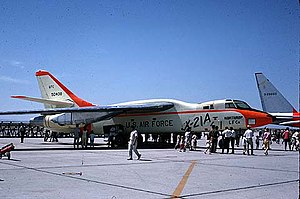Northrop X-21
| X-21 | |
|---|---|
 |
|
| Northrop X-21A | |
| Role | experimental aircraft |
| Manufacturer | Northrop |
| First flight | 18 April 1963 |
| Introduction | experimental |
| Retired | 1968 |
| Primary user | National Aeronautics and Space Administration (NASA) |
| Number built | 2 |
| Developed from | Douglas B-66 Destroyer |
The Northrop X-21A was an experimental aircraft designed to test wings with laminar flow control. It was based on the Douglas WB-66D airframe, with the wing-mounted engines moved to the rear fuselage and making space for air compressors. The aircraft first flew on 18 April 1963 with NASA test pilot Jack Wells at the controls. Although useful testing was accomplished, the extensive maintenance of the intricate laminar-flow system caused the end of the program.
Laminar-flow control is a technology that offers the potential for significant improvement in drag coefficient which would provide improvements in aircraft fuel usage, range or endurance that far exceed any known single aeronautical technology. In principle, if 80 percent of wing is laminar, then overall drag could be reduced by 25 percent. The frictional force between the air and the aircraft surface, known as viscous drag, is much larger in a turbulent boundary layer than in a laminar one. The principal type of active laminar-flow control is removal of a small amount of the boundary-layer air by suction through porous materials, multiple narrow surface slots, or small perforations (boundary layer suction).
Two major modifications were required, the first involving the standard underwing podded Allison J71 engines being removed and replaced by a pair of 9,490 lbf (42 kN) static thrust General Electric XJ79-GE-13 non-afterburning turbojets mounted in pods attached to the rear of the fuselage sides. Bleed air from the J79 engines was fed into a pair of underwing fairings, each of which housed a "bleed-burn" turbine which sucked the boundary layer air out through the wing slots.
The X-21A test vehicles (55-0408 and 55-0410) also incorporated sophisticated laminar flow control systems built into a completely new wing of increased span and area, with a sweep reduced from 35° to 30°. The wing had a multiple series of span-wise slots (800,000 in total ) through which turbulent boundary-layer was "sucked in," resulting in a smoother laminar flow. Theoretically, reduced drag, better fuel economy and longer range could be achieved.
The forward cockpit carried a pilot and two flight engineers while two additional flight test engineers were housed in a central fuselage bay underneath the wing.
...
Wikipedia
